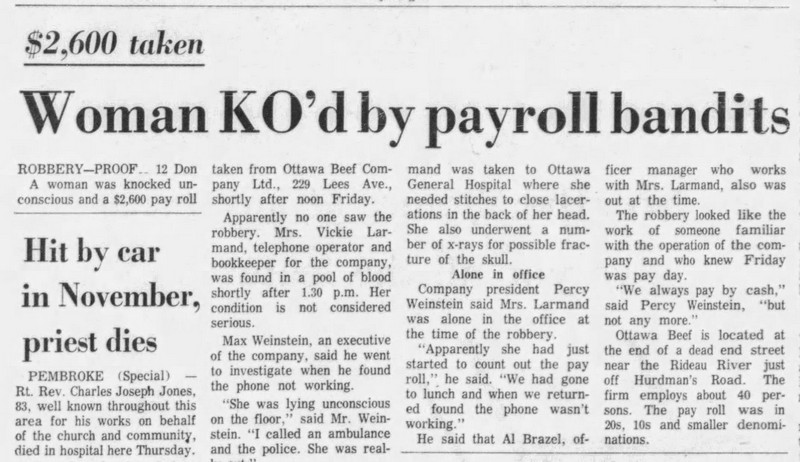Ken’s Bygone Sandy Hill
Robbery and intrigue at Ottawa Beef Co. Ltd.
Ken Clavette
If having the largest abattoir in the city made Sandy Hill feel like it was part of the wild west in the past, then robbery at the Ottawa Beef Company would fit right in. On Friday, Jan. 22, 1965, the manager found the company’s telephone operator and cashier/bookkeeper lying on the floor of the office, unconscious, in a pool of blood, and the cash payroll she was working on gone. Located at the end of Lees Avenue in Hurdman Village (also known as Robinson Village), the company was on a dead end at the Rideau River. The location meant the business did not have passing traffic, and with the managers out for lunch, along with the other 40 employees, there were no witnesses to the crime.
The Citizen reporter covering the robbery noted that it “looked like the work of someone familiar with the operations of the company and who knew Friday was pay day.”

Several months later the headline in the May 5 edition of the Ottawa Citizen read “Butcher admits robbing employer.” Claude Pelletier, 37, of Hull, had been apprehended by the Ottawa police and appeared in Magistrate Glenn Strike’s court. Detective Lecompte testified that “a rubber hose was used to strike cashier Vicki Larmond on the head.” Pelletier said he and an accomplice had hidden “the $2,536 in the meat packing house, returning the next day and picking up the loot.” The detective told the court the money had not been recovered. Pelletier pleaded guilty to the charges.
Then, on May 6, a story appeared in the paper that the injured woman had been charged by Ottawa Police with conspiracy to robbery. Mrs. Larmond, 26, of Eastview, along with Bernard Fournier, 27, of no fixed address, were charged as accomplices. On May 8, the paper reported that police had arrested Fournier. Both Pelletier and Fournier were employees of Ottawa Beef.

“Evidence Reduces Jail Term” the May 26 headline read. Pelletier was sentenced to four years in penitentiary, having been given a reduced term for assisting the police. Detective Lecompte told the court Pelletier had been approached by two coworkers with a plan to commit a robbery. The magistrate said, “in view of Pelletier’s ‘pretty bad record,’ the sentence would ‘actually have been three times as long’ if this new information hadn’t come to his attention.”
At the Fournier trial on June 18, there was surprising testimony. Pelletier’s father, Albert, claimed that the two men had met at his cottage in West Templeton to split the money after the robbery. “He said each man got $750 and $1,000 was set aside for the woman” whom, he said, they did not name. He said he was given $125 for an operation he needed. That amounted to $2,650 in total. Claude Pelletier, who was already serving four years for carrying out the crime, claimed the two men had met twice to plan the robbery. Another witness, Mrs. Lilian Leduc, told the court the two men left a package at her home where Pelletier was staying, telling her not to open it because it was “none of her business.” She testified that she later opened it and found money inside. Mrs. Larmond denied knowing anything about the robbery that left her unconscious and in hospital for several days.
For his part, Fournier confessed only to a summer visit to the elder Pelletier’s home but not to the cottage where the money was split, and he stated the testimony given was false. He denied meeting with coworkers to plan a robbery of their employer. In a surprise move, the owner of Ottawa Beef, Mr. Max Weinstein, testified for Fournier’s defense, saying that before he found the bookkeeper lying unconscious in a pool of blood, he “had noticed Fournier going about his duties normally about the time of the robbery.” Magistrate Sauve told the court he would reserve his decision until he had read and studied the “conflicting testimony.”

On August 12, the Citizen reported that Sauve had dismissed the charge of conspiracy to rob against Bernard Fourier, saying the Crown Attorney had failed to present evidence to make a case against the accused. He also remanded the now-unemployed Mrs. Larmond to an August date to review the evidence against her.
But by August, the story disappeared from both the Ottawa Citizen and the Ottawa Journal. There were no articles about a hearing for Mrs. Larmond. Did she appear in court or not? Did the police drop the charges against her given that she faced the same evidence that Magistrate Sauve already dismissed in Fournier’s case? The police had used the evidence of Pelletier to lay the charges, but it was rejected by the court. Was the evidence of a man with a long criminal record given against the others hoping the court would reduce his sentence, as it did? Was he an innocent dupe taken in by his coworkers as he claimed? Or was he the lone bandit that knocked a woman unconscious making off with the company payroll in a crime befitting the wild west of Sandy Hill’s slaughterhouse?
In case you are wondering — the $2,536 in 1965 would be valued at almost $22,000 today. Where did that money go? We may never know.

